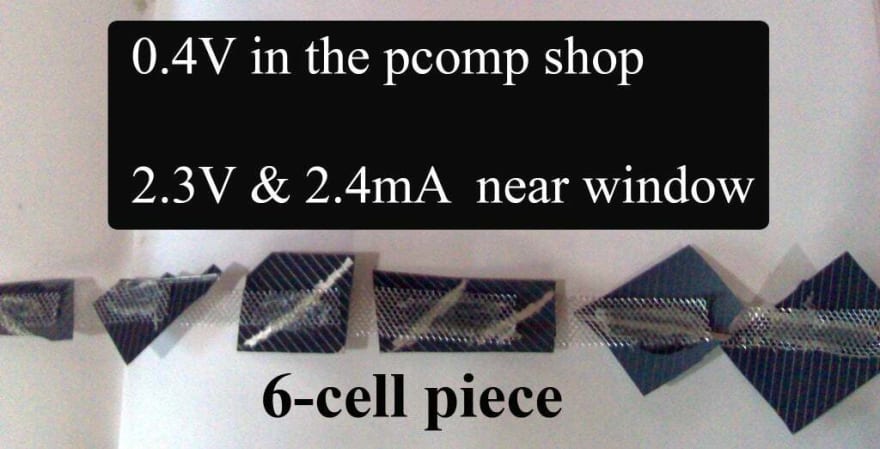Creating a solar panel out of broken re-used solar cell pieces. In addition, you will need some conductive copper mesh (available at most art stores), glue gun + sticks, a multimeter and a conductive pen (or any sort of conductive brush-on -
I got my conductive silver pen here). In this tutorial, I will try to explain the best technique I found to connect these broken cells, in order to create your own CHEAP solar panel.
Step 1: Get the Solar Cells
this is how the cells can look like when they arrive
Step 2: Check Power and Ground
When you look at the solar cell, make sure you check voltage between the positive side (the back side which is usually grey) and the negative side (which is the black side, with all the lines on it) of each cell.
You can simply use a multimeter by placing its leads on the cell itself. This step is crucial, otherwise you'll connect bad cells in the middle of your link, causing the whole panel not to work.
Step 3: Use Conductive Pen If Needed

You need to make sure that all the tiny little lines in the negative side of the cells are interconnected (a way to gather all the electrons from the surface).
This step is not necessary for all cells, only for the ones like in this picture, which don't have any connection between the lines on the surface.
You can use the conductive pen to draw a thin line which connects all of them. Once you do that, you will immediately see the voltage rising for that specific cell.
Step 4: Cell With Conductive Pen Line
here's an example of a cell with the conductive pen line on it, linking between the tiny conductive leads on the negative side of the solar cell.
Step 5: Linking the Cells
This can get a bit tricky, but once you get the hang of it, can be done fast enough. First, some technical notes: In order to get higher voltage, you need to connect two cells in series.
This means that the negative part of the first connects to the positive part of the second. As you continue to add more cells in series, you will get a higher voltage from side to side on your solar strip. This is all good, but if your cells are small-ish, they won't generate much amperage.
So even if you have a high voltage, you probably won't be able to give it any load (probably will hardly light an LED).
In order to get higher amperage through the circuit, you need to connect cells in parallel (positive side to positive side, negative side to negative side).
When you do this, make sure the positive and negative leads (copper mesh in this case) don't short themselves out.
I found that the best way to connect between two cells was to use hot glue and some conductive mesh.
The mesh is good since it allows light to come through it, and we all love glue guns. So all you need to do is glue the mesh onto the solar cell surface.
Its always better to have a longer strip of mesh on the surface, with a big enough shared surface space between the two.
Always check with a multimeter that there is connectivity, and that there is voltage coming through. Its a bummer later to try and figure out where the problem is.
Step 6: Example Measurement for 2-cell Link
Step 7: Example Measurements From a 6-cell Link
This solar array can light an LED when close to the window. (I know... doesn't help much)
But it can definitely charge a battery... (instructable still in the making...)
Step 8: Silicon Coating
I highly recommend applying a silicon coating to your solar array. The cells are so fragile, and the links can easily detach or move out of place. A thin coat of silicon keeps it all in place... and also gives it a very cool effect!
Step 9: Solar Jelly
A little Solar Jellyfish. I put a battery and servo motor inside. When there was enough light on it, the object moved its legs up and down just like a jellyfish (video coming very soon...). And when it was dark, it lit up from inside and became a light display.
A bit messy, but still a prototype.
Step 10: Hope This Helped
Congratulations! You have now created a solar cell!
You can measure the output of the cell by attaching alligator clips to both of the exposed parts of the plate and to the leads of the voltmeter (dial now set to millivolts). mine generates about 25 millivolts when exposed directly to sunlight (simulated with a lamp)
You have now created a working solar cell!
This could be the start of something bigger, one individual cell does not produce a lot of electricity but if you were to make multiple larger versions of these it could really produce quite some electricity. Use your imagination!
Feel free to leave any suggestions in the comment section!












Top comments (1)
That's a tricky question. On one hand that looks really creative and interesting. And for some playing purposes can be used. But if you want to save energy in your house, you'd better read solarsystems.reviews about everything that is solar panels related. There, you can also check with the providers, if you wish.